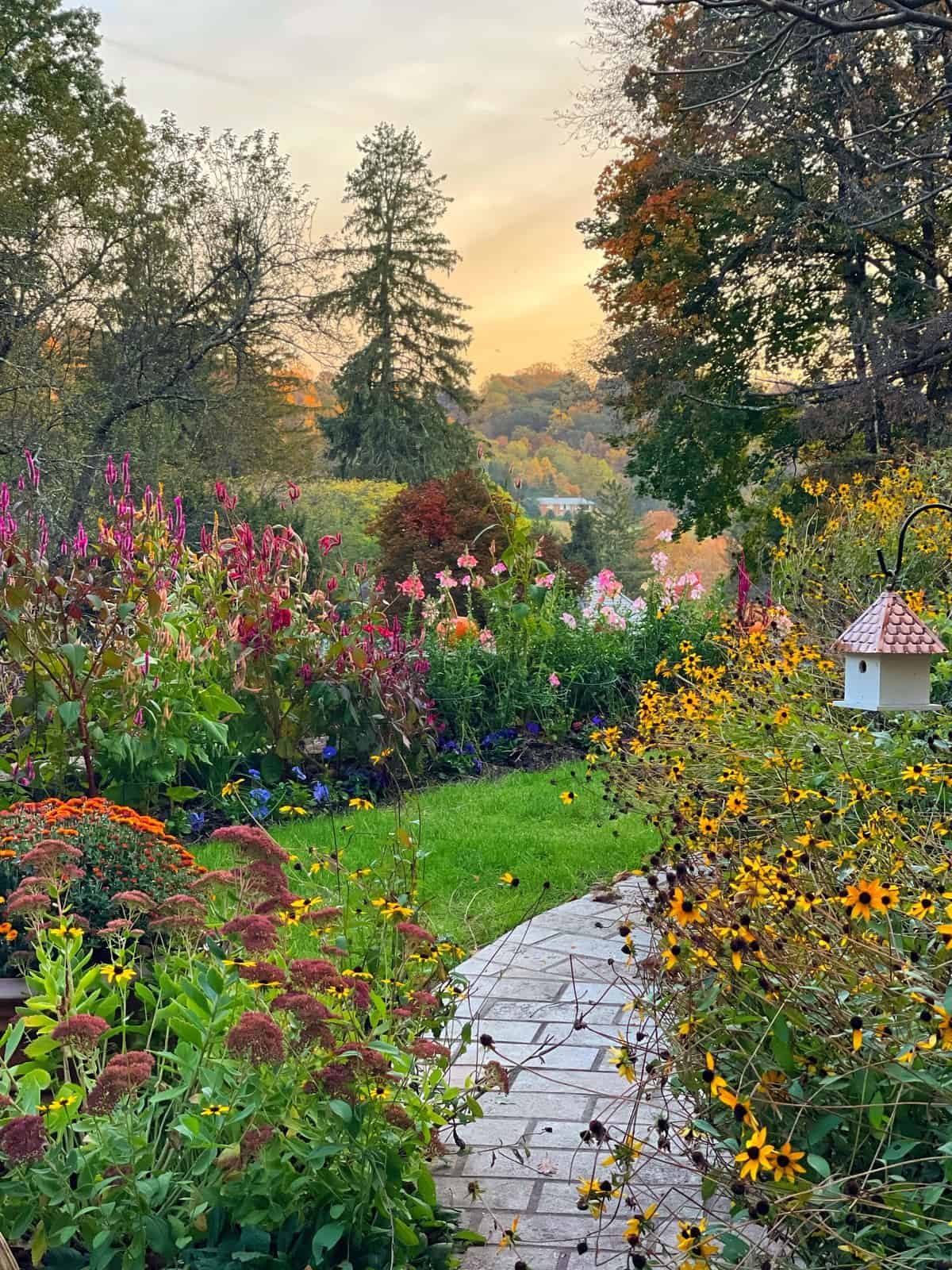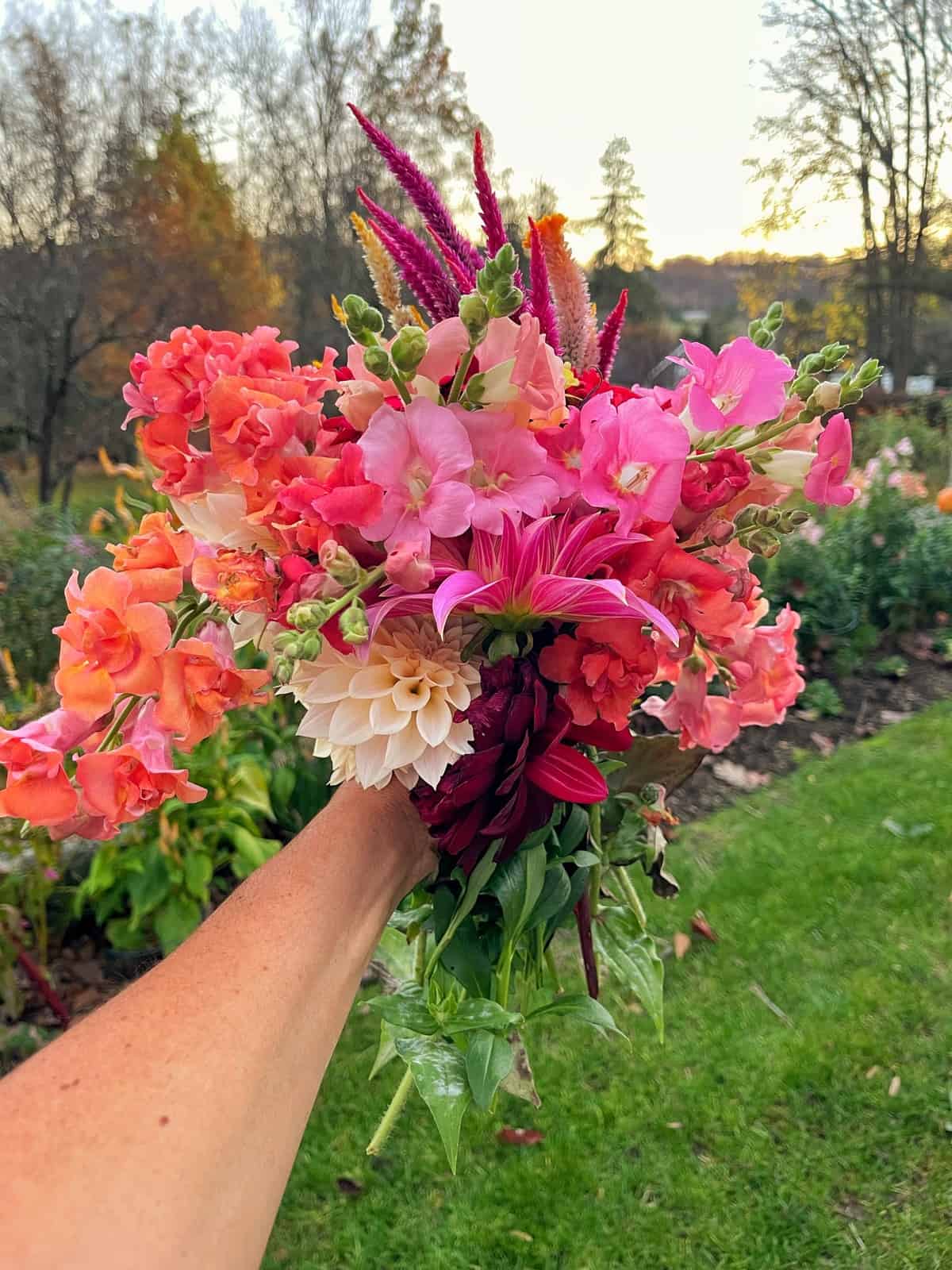Grow vibrant celosia plant for beautiful cut flowers! Learn how to sow seeds, care for plants, and enjoy stunning blooms.
If you’ve never grown celosia plant before, you are in for a treat today. It is such a unique flower that adds a lot of interest to the garden, as well as bouquets. I’ve been growing it for quite some time and with each gardening season, I add more and more to the beds.
It’s a great flower for the landscape but looks equally beautiful in containers too. And while it blooms in summer, to me, it shines as a must-have fall garden flower. Wait until you see how easy celosia is to grow and how you can enjoy the blooms.
(Posts on stacyling.com may contain affiliate links. Click HERE for full disclosure.)

Exploring Celosia Varieties (Cockscomb)
The low-maintenance, high-impact celosia plant belongs to the Amaranthaceae family. Celosia is one of the most eye-catching flowering plants because of its 3 distinct shapes. There are three types of celosia: plumed, wheat, and cockscomb.
- Plumed varieties (celosia plumosa) have multiple flower stalks and blooms with a feathery appearance. They are often between 8 and 24 inches tall.
- Wheat varieties have a singular flower stalk and look similar to the head of a grain crop. These are often between 12 and 36 inches tall and are the most limited in colors compared to the plumed and cockscomb varieties.
- Cockscomb or crested varieties (brain flowers) have coral or brain-looking blooms that are often large and heavy so they must often be staked. They grow between 12 and 36 inches tall.

6 Compelling Benefits of Growing Celosias: Easy Care, Vibrant Colors, and More
With its stunning looks and vibrant colors, celosias bring a plethora of benefits to your garden. Here’s why you should grow it this year.
Enhancing Garden Texture, Color, and Charm with Celosia Flowers
At the heart of celosia’s appeal is its vibrant and diverse range of colors, texture, and shapes. Whether you’re a fan of fiery reds, sunny yellows, or soothing purples, celosia has a hue that’s for you. Its unique forms, from plume-like to crested blooms, add a touch of whimsy, charm, and visual interest to the garden.
Effortless Gardening: Easy-Care and Low-Maintenance Plants for Beginners
If you want to grow an easy-care, low-maintenance garden, the celosia plant is a great choice. It’s not fussy about soil conditions, thrives in sunny spots, and can handle a little neglect. Plus, it’s relatively drought-tolerant once established, reducing the need for constant watering.

Attract Bees and Butterflies: The Benefits of Growing Celosia as Pollinator-Friendly Plants
If you want to support pollinators, celosia’s nectar-rich flowers are like a five-star restaurant for butterflies, bees, and other beneficial insects. By welcoming these pollinators, you’re contributing to the health of your garden and the ecosystem as a whole.
Enjoy Season-Long Color: Celosia Delivers Long-Lasting Blooms
Celosia’s blooms aren’t just a fleeting affair. These beauties have staying power! Whether you’re enjoying them in your garden or snipping them for indoor arrangements, celosia’s blooms will grace your space until the first frost. They are cut and come again, so keep cutting to get more flowers.
Stunning Floral Displays: How Growing Celosia Enhances Your Home with Eye-Catching Cut Flowers
Speaking of arrangements, celosia flowers look incredible as cut flowers in arrangements. Its unique forms and vibrant colors add a touch of whimsy and elegance to bouquets and centerpieces. To me, you can’t have too much of this plant because it looks amazing both in your home and out in the garden.
Transform Your Garden: Celosia’s Role in Creative Landscaping
Celosia’s diverse sizes, texture, and vibrant colors make it a versatile addition to your garden design. Whether you’re using compact varieties in borders, mid-sized ones in mixed beds, or towering types as focal points, celosia’s flexibility lets you get creative with your landscaping. They can be grown in containers and look beautiful in mixed-fall garden planters. And if you want to preserve the blooms? The flowers dry with ease too!

Comprehensive Guide to Celosia Plant Care: Planting Watering, Sunlight, and Fertilization Tips
Gorgeous celosia has a USDA hardiness zone of 10-11 so it is generally treated as an annual. However, in zones 9 to 11 celosia might surprise you by acting like a short-lived perennial. From my experience, and I’m in gardening zone 6b, this easy-care annual drops seed, self-sows, and returns yearly.
In order to thrive, celosia flower needs 6-8 hours of full sun per day and should be planted in well-draining soil. Flowers appear beginning in early to mid-summer and the blooms continue through to fall.
- Plant after all danger of frost passes in well-draining soil that is rich in organic matter.
- Deeply water the base of plants in the earlier part of the day. In the heat of summer, you’ll likely be watering it daily to keep the plant hydrated during extreme heat.
- Fertilize with a well-balanced fertilizer. I prefer to use a slow-release fertilizer when I plant so it is set and forget.
- Deadhead spent blooms and cut flowers so your celosia plant produces more flowers until the first frost.
- Pests and diseases are usually not a problem with this hardy plant, but occasionally issues with snails and slugs can occur. To avoid root rot and fungal issues, plant in well-draining soil.
When we first moved here, I had no idea it was planted in years prior. So imagine my surprise as it emerged that first summer and leveled up my garden with its gorgeous flowers.

Growing Celosia in Pots
Growing celosia in pots is a brilliant solution for those who are short on garden space or are just beginning their gardening journey. Celosia’ compact size and relatively low maintenance needs make it a perfect choice for container gardening. Their adaptability to small spaces allows urban gardeners to infuse color and charm into their surroundings, even without a traditional garden bed.
With well-draining soil, a sunny spot, and watering, celosia can thrive in containers. They make beautiful container plantings both on their own when combined with other plants that like similar growing conditions.

Step-by-Step Guide: Starting Celosia From Seed Successfully
While you can find a few varieties at the nursery, there are so many more beautiful options to grow if you start celosia plants from seed. Plus it is a rewarding and cost-effective way to fill your garden with vibrant blooms. This step-by-step guide will take you through the essentials of sowing celosia seeds both indoors and outside, ensuring optimal germination and strong, healthy seedlings.
Seed Starting Supplies for Celosia: Top Tools for Indoor Germination Success
- Celosia Seeds
- Vermiculite
- Seed Starting Potting Soil
- Seed Trays
- Bottom or Drainage Trays
- Clear Dome Lids
- Grow Lights
- Shelf System for Seedlings
- Heat Mat
- Plant Labels
- Oscillating Fan
- Programmable Timer

How to Sow Celosia Seeds Indoors
- Gather Supplies: Collect seed starting mix, trays or pots, vermiculite, and labels. Find a warm, well-lit spot in your home.
- Timing: Start seeds indoors 6-8 weeks before your last expected frost. Check your seed packet for specific recommendations.
- Fill & Sow: Fill pots with moistened seed starting mix. Sow 1-2 seeds per cell, covering lightly with vermiculite.
- Label & Cover: Label your trays. Cover with a clear plastic dome and place on a heat mat under grow lights.
- Light & Warmth: Provide 14-16 hours of light per day using a timer.
Additional Tips:
- Use fresh seed starting mix to prevent diseases
- Keep soil consistently moist but not soggy
- Remove the dome once seedlings emerge

Caring for Celosia Seedlings
- Monitor Germination: Check seedlings daily; most germinate within a week.
- Light & Air: Once sprouted, remove the dome and place trays under grow lights, adjusting height as seedlings grow.
- Bottom Watering: Water from the bottom to prevent dampening off. Allow soil to dry slightly between waterings.
- Transplant Outdoors: Harden off seedlings gradually before transplanting after the last frost.
If you have questions about this process or want to dive a little deeper into the process, read my article about starting seeds indoors.
Direct Sowing Celosia Seeds in Your Cut Flower Garden
While you can sow celosia seeds indoors, it works equally as well if you directly sow them in the garden too. Seeds can also be directly sown after all danger of frost passes and the soil temperature is at least 60 degrees. In my zone 6b garden, celosia grows with ease, so either method works well. For more direct sowing flowers in your garden tips, read my article here.

Harvesting Celosia Seeds
Allow the celosia flowers to fully mature and dry on the plant. The seed heads will turn brown and papery and you’ll start to notice the little black seeds on the plant.
Gently shake or rub the dried seed heads over a clean container or sheet of paper to release the seeds. For smaller quantities or specific varieties, you can even carefully hand-pick the seeds from the dried flower heads.
If the collected seeds may contain chaff (plant debris). To clean, you can use a fine-mesh sieve or gently blow on the seeds to remove the lighter chaff.

Saving Celosia Seeds
- Drying: Spread the cleaned seeds in a single layer on a paper towel or screen to ensure they are completely dry. Allow them to air-dry in a cool, dry place for several days.
- Storage: Store the dry seeds in an airtight container or envelope. Label the container with the variety and date of collection.
Seeds should be stored in a cool, dark, and dry location. A refrigerator or a dedicated seed storage area is ideal. Properly stored celosia seeds can remain viable for several years, although germination rates may decline over time.
Additional Tips
- Disease Prevention: Inspect the plants for signs of disease before collecting seeds. Avoid saving seeds from unhealthy plants.
- Hybrid vs. Open-Pollinated: Seeds saved from hybrid celosia varieties may not produce plants identical to the parent plant. Open-pollinated varieties are more likely to breed true.

Top Reasons Why Celosia is the Perfect Cut Flower
Ever wondered why the celosia plant makes a great cutting flower? Here’s why it is a popular cut flower garden bloom.
- The flowers last a long time, even after they are cut.
- Celosia plant flowers have a unique eye-catching appearance.
- They add lots of texture, color, and interest to bouquets and centerpieces.
- The flowers are low-maintenance in a vase.
- You can use the flowers after they dry out in other home decor like wreaths, vintage crocks, milk glass vases, and other thrift store finds.

Perfect Pairings: Flowers that Complement Celosia in a Stunning Bouquet
There are lots of flowers that look beautiful with celosia in a bouquet, centerpiece, or other arrangement. Here are a few cut flower ideas that pair well.
- Dahlias
- Zinnias
- Snapdragons
- Strawflowers
- Calendula
- Amaranth
- And so many more!

How to Dry Celosia Flowers
Celosia is easy to dry and looks gorgeous after it does. Cut the flowers when they are fully developed in the early part of the day after the dew has dried.
For dried arrangements, remove all the leaves from the stems, wrap a rubber band around six to eight stems, and hang them upside down in a dark, cool, dry, airy space for several weeks or until fully dried. They will last in dried arrangements for at least six months without losing any of their vibrancy.

Celosia FAQs: Answers to Your Most Common Questions About Growing and Caring for Celosia
Cultivating these stunning blooms might raise questions, especially for beginners. In this section, I’ll address some frequently asked questions about growing celosia, providing you with insights and tips to nurture these remarkable plants with confidence.
Does celosia plant spread?
Celosia flower is known to exhibit some degree of reseeding in the right conditions. Here’s what you need to know:
- Seeds: As celosia plants mature and produce blooms, they also produce seeds. These seeds can fall to the ground or be carried by the wind.
- Self-Sowing: In some cases, celosia seeds that fall to the ground can germinate and grow into new plants on their own. This is known as self-sowing or natural reseeding.
- Climate Consideration: The likelihood of celosia reseeding can depend on your climate and growing conditions.
While celosia’s reseeding potential can be a wonderful surprise, you may want to manage it to maintain a well-organized garden:
- Selective Deadheading: If you want to encourage reseeding, leave some spent blooms on the plant to allow them to go to seed. However, if you want to control reseeding, deadhead the flowers before they form seeds.
- Seed Collection: If you’d like to have more control over where and when celosia reseeds, you can collect the seeds from mature blooms and store them for intentional sowing in the next growing season.

How do you keep celosias blooming?
To make the most of celosia’s summer blooms and extend its flowering performance, follow these tips:
- Location: A sunny, dry, and warm location will keep celosia healthy and blooming.
- Deadheading: Regularly deadhead spent flowers to encourage the plant to keep producing new blooms.
- Fertilizing: Providing a balanced fertilizer during the growing season can help sustain the blooming period. I like to use a slow-release fertilizer like this.
- Watering: Consistent watering without overwatering will keep celosia hydrated and blooming. Only water when the top 1-2 inches of soil are dry.
Is celosia toxic to dogs?
Celosias are not poisonous to cats, dogs or humans. The plants can be kept in any home without any problems. In some regions, celosia is even used in medicine and cooking.


Top Celosia Varieties to Grow: Favorite Types for Vibrant Color and Unique Texture
There are so many different varieties of celosia to love. But here are a few of my favorites that I start from seed.
- Flamingo Feather
- Ruby Parfait
- Crystal Beauty
- Pampas Plume
- Cramer’s Rose
I’m looking forward to Floret Flower Farm’s new celosia varieties and can’t wait to tell you about them. This year I’m growing Raspberry Lemonade and Vintage Rose..

More About Growing Celosia Plant
Do you enjoy growing Celosia too? Have you ever started it from seed before? I would love to know more in the comments below.
For more information about growing celosia, please see this article from the University of Minnesota Cooperative Extension.
To drill down on more beginner gardening techniques and tips, please read these posts:
- Flower Gardening 101
- Growing a Cut Flower Garden for Beginners
- Container Garden Ideas for Beginners
- How to Start a Vegetable Garden
- Herb Gardening for Beginners
If you have any questions, comments or suggestions, please let me know in the comments below. I’d love to hear! And feel free to share this post with anyone you think would find it helpful too.
Happy Gardening!








